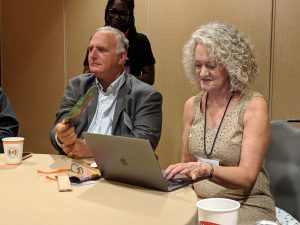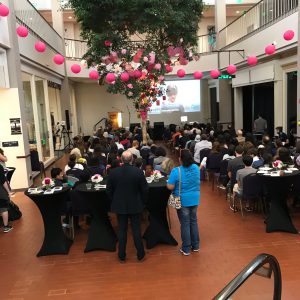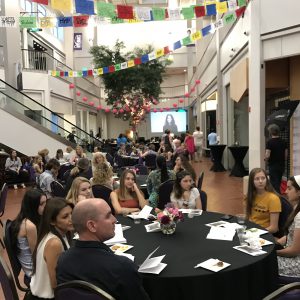The month of April has come and gone, and it included two conferences (the American Association of Community Colleges annual convention; the Texas Pathways Institute #6) along with the always swirling work in support of student success.
There were many days from which to choose for this month’s day in the life, but I’ve settled on Friday, April 26. Friday was the concluding day of the three-day Texas Pathways Institute #6. These Institutes are supported by the Texas Success Center (an arm of the Texas Association of Community Colleges); 48 of the state’s 50 community colleges participate by sending a small team to each Institute. The Texas Association of Community Colleges (TACC) is an advocacy organization supported by all 50 community colleges in its efforts to influence higher education policy-making as well as innovation around the state. The Texas Success Center then provides direct support to Texas community colleges engaging in work to support student success.
Each Pathways Institute is a mix of plenaries, concurrent sessions, and team time. ACC took a large team to Institute #6 – approximately 30 folks (we think we set a record!). Our team was heavily weighted to instruction (it consisted of adjunct and full-time faculty, department chairs, deans, and Continuing Education), and also included Student Affairs representatives. Each Pathways Institute has an overarching theme, and Institute #6 was focused on “Ensuring students are learning”.
Colleges do “homework” prior to each Pathways Institute. This Institute asked us to conduct a student focus group, to map learning outcomes in a degree plan to look for curricular coherence, and to update our Scale of Adoption Assessment (SOAA) that we initially completed in 2017. (This SOAA document requires the college team to assess how our work is going in adopting the pathways principles and framework to better serve our students.) Each Institute especially includes several sessions of team time, during which we answer guiding questions that lead us ultimately to brainstorming our latest short-term action plan.
Because we took 30 members of our team (typically we take 15), we divided into two teams, and I was asked to lead the discussions of Team 2. How do we ensure that students are learning? How do we ensure curricular coherence for students? How do we ensure that students know what they need to know when they need to know it so that they can navigate our systems and processes? Different students need different things at different times – so the concept of differential supports is embedded our work. This picture illustrates differential supports in action. 
As team leader, I was taking notes while also guiding the discussion. As a middle-aged woman, I was uncomfortably hot and wanted (needed) to fan myself. But I couldn’t do both. So a friend and colleague in Student Affairs (thanks, Wade!) picked up my fan and spent ten or more minutes fanning me while I typed and asked questions of the team. No one else at the table needed to be fanned – but Wade understood that I did, and he helped. That was not just collegiality, it was awareness and attention that led to action. To extend the metaphor, sometimes an individual student might need to be fanned, and we have the ability to turn awareness of a particular need into action to meet that need. That is key to helping our students succeed, one by one, offering the support that will make a difference each step along the way.
Our Friday morning at the Pathways Institute ended at noon, at which point we all gathered our suitcases to head back to Austin (the Institute was in San Antonio). I had hitched a ride with the Provost and the Vice President of Instruction, so we got back on the road around 12:30 with Dr. Cook behind the wheel (thanks for driving, Dr. Cook!). It was Fiesta time in San Antonio, so it took us a while to find a circuitous route around the parade to I-35, but Mike navigated us with aplomb from the back seat. It was also a Friday afternoon, which means I-35 was slow – and made slower by an accident that had northbound traffic stopped. All in all, it took us three hours to get back to HBC, so I was back in the office by 3:30.
Dr. Cook had asked me to send him the results of our team time and the brainstorming around our next short-term action plan, so I finalized that and sent it to him soon after we got back to HBC. From there I turned to catching up on emails and attempting to cram 2 1/2 days of work in the office that I had missed into three hours.
My day concluded by attending the 7 o’clock Vision+Voice reception in Building 4000 at HLC If you’re not familiar with Vision+Voice, it’s an annual poetry contest for our K-12 partners, not just in AISD but in surrounding independent school districts. Winners are selected from kindergarten entries through 12th grade. It is a lovely evening with families and schoolchildren and ACC faculty and staff all celebrating the power of words. Each winning poet is recorded by KLRU reading their poem, and the videos are played at the event.
Each winning poet is recorded by KLRU reading their poem, and the videos are played at the event. 
It’s a wonderful evening – look for the latest Vision+Voice Anthology to read the creative and impactful poems of our area schoolchildren. I’ll leave you with poem from a 5th grader. This will remind you of the reasons we put in long days at ACC in service to the communities of Central Texas.
Hate Burned Out
Hudson R., Ridgetop Elementary
The fire made by hate
Was long ago extinguished
By love.
Picture credits: Missi Patterson (Pathways fanning) and Matthew Daude Laurents (V+V crowds)
